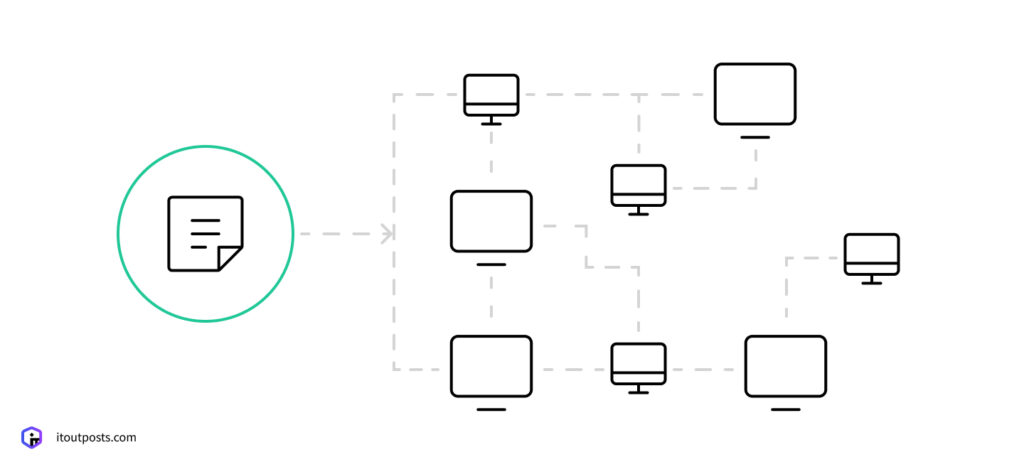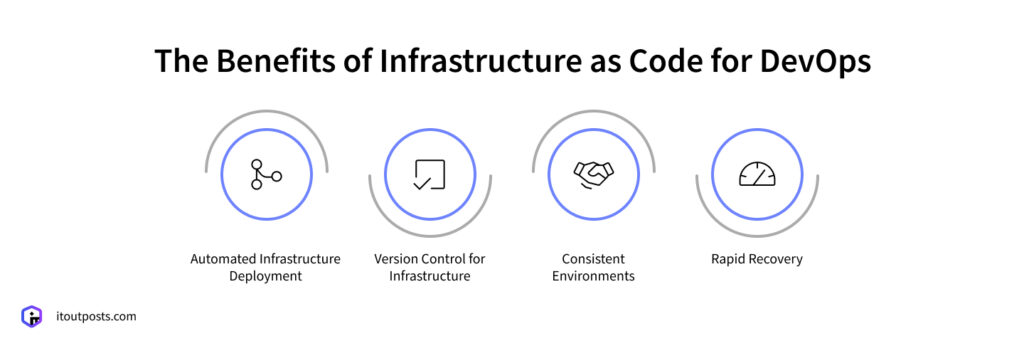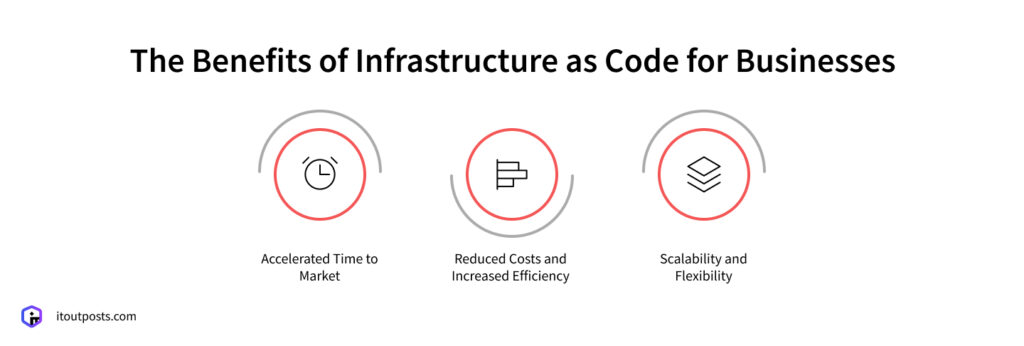Contents
Moving your company’s infrastructure to code will give your business a significant upgrade. Manually setting up servers and systems will no longer be necessary. Your team will simply write instructions that automate the entire process.
But most importantly, this approach isn’t just about making life easier for tech teams. It helps businesses save money, develop faster, and stay ahead of competitors (yes, your competitors will still be clicking through control panels while your systems will deploy themselves). Let’s explore the concrete ways how infrastructure as code (IaC) can impact your company’s bottom line.
What Is IaC?

Infrastructure as code is a method in which developers configure a computing system’s infrastructure through machine-readable definition files instead of physical hardware setups or using interactive configuration tools.
In other words, every server, database, network configuration, and security rule is defined in lines of code. This code becomes the system’s way of defining what your infrastructure should look like and how it should behave, and it can build very complex systems with a few commands.
Why Does IaC Matter for Businesses?
Businesses launch and update multiple apps daily and have to adjust their digital infrastructure regularly to match user needs. For instance, their servers must start up in the morning, power down during quiet hours, and expand instantly when a product goes viral. Staying ahead of these demands isn’t just about remaining in the game — it’s about actually being in this game.
IaC saves companies a lot of time and effort on challenging business infrastructure processes by automating the management, allowing companies to operate at the speed the market requires.
The Benefits of Infrastructure as Code for DevOps
Before we expand on the benefits of IaC for businesses, let’s first determine the capabilities of IaC for DevOps so you can understand exactly how it works.

Automated Infrastructure Deployment
So, as we’ve found out, thanks to IaC, DevOps teams can deploy entire infrastructure stacks with a few lines of code. This means they don’t have to spend hours manually configuring servers, networks, and databases but rather define everything in tools like Terraform or AWS CloudFormation.
One command can spin up hundreds of perfectly configured resources across multiple cloud providers. This is how you save your organization from human error and speed up deployment from days to mere minutes.
Version Control for Infrastructure
Every infrastructure change can be tracked in version control systems like Git. This way, everyone will see who modified the infrastructure, what changes were made, and their reasoning behind every change. Furthermore, engineers can quickly roll back to the last known working configuration with newfound ease. Such systems provide a complete audit trail that makes troubleshooting more efficient.
Consistent Environments
It’s quite common for development teams to deal with environment inconsistencies. However, IaC ensures that every environment is configured with the same code. Thus, developers can write code in the development environment, knowing that it will work in production with no issues. This saves teams countless hours that would typically be spent debugging environment-specific problems.
Rapid Recovery
And when systems face any issues, teams no longer need to manually recreate the servers but return to a good state with the help of, again, IaC. It makes disaster recovery a repeatable process. This is a significant plus when it comes to emergency situations since, otherwise, you’d have to deal with a stressful manual operation. But with IaC, recovery times drop from hours to minutes.
How Do These Benefits Translate into Advantages for Your Business?
Now that we’ve analyzed the technical aspects of the impact of IaC on DevOps, let’s see how this can potentially help your company as a whole.

Accelerated Time to Market
Suppose you have an idea for a new feature you’re sure will impress your users. With IaC, you can turn this idea into a reality much faster. You can reduce the time it takes to go from a concept to a ready solution by automating the infrastructure deployment process.
There’s no more need to wait for days or weeks while servers are manually set up and the environment is configured. Your engineers can provision new development and testing environments in just a few clicks and start working on your feature right away.
Reduced Costs and Increased Efficiency
As the saying goes, “Time is money.” But the harsh reality is that when your DevOps team has to deal with manual infrastructure management, it’s not just their time that’s wasted. Your company is spending resources as well.
Incorporating IaC allows you to optimize processes and eliminate the inefficiencies that constantly eat away at your bottom line. In addition, you’ll be able to better manage how you use your infrastructure resources. Scale up or down based on demand, and this will limit the amount you spend.
Scalability and Flexibility
It’s cliched to say business is always evolving, but it’s true. No matter if you’re facing shifting market conditions or customer expectations, or altogether, your infrastructure must always be ready for change.
IaC allows you the luxury of scaling or adapting your infrastructure whenever you need, without facing any difficulties. Say, for example, when sudden surges in traffic happen, new resources can be quickly spun up. IaC makes it easy for you to change and advance without rigid infrastructure holding you back.
Break Free from Manual Constraints with IT Outposts!
The time spent on defining your infrastructure in machine-readable configuration files pays off for your business in a big way, saving lots of time and money in the long run.
We offer infrastructure as code implementation as part of our comprehensive package called AMIX Infrastructure. It’s an unbeatable offer at a price point you won’t find anywhere else, especially considering the level of professionalism we bring to the table.
